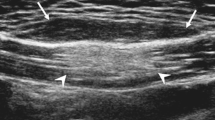Summary
In this investigation we have examined how often and under what conditions microthrombi occur in lipomas of biopsy material.
The investigation gave the following results:
-
1.
In 300 non-selected lipomas from different regions of the body 124 (41.3%) showed microthrombi, most of which were of various ages. In 43 lipomas we found an intense microthrombosis with more than 20 microthrombi in each slide.
-
2.
There was a greater and more significant incidence of microthrombi in the lipomas of the extremities than in those of the trunk. In these regions they were significantly more frequent than in the lipomas of the head and neck regions.
-
3.
In normal adipose tissue we rarely found microthrombi; they were very frequent in cavernous hemangiomas (25 in 32 cases) however.
-
4.
There is a relation between the vascularization of the lipomas and the frequency of microthrombosis. There is a significantly greater incidence of microthrombi in the angiolipomas than in the poorly vascularized tumors, as calculated for all tumors of the whole body or for different regions of the body.
-
5.
Angiolipomas are to be regarded as natural miniature models of chronic local consumption of blood-clotting components.
-
6.
Microthrombi in lipomas make it possible to differentiate them from normal adipose tissue.
Zusammenfassung
Ziel der Arbeit war es zu prüfen, wie häufig und unter welchen Bedingungen Mikrothromben in Lipomen eines bioptischen Untersuchungsgutes vorkamen. Die Arbeit führte zu folgenden Ergebnissen:
-
1.
Von 300 unausgewählten Lipomen verschiedener Körperregionen wiesen 124 (41,3%) Mikrothromben, meist unterschiedlichen Alters, auf. Bei 43 Fällen wurde eine starke Mikrothrombose mit über 20 Mikrothromben pro Schnittpräparat ermittelt.
-
2.
Mikrothromben kamen in Lipomen der Extremitäten signifikant häufiger vor als in denen des Rumpfes und waren in diesen beiden Körperabschnitten hochsignifikant häufiger als in den Lipomen des Kopf- und Halsbereiches.
-
3.
Im normalen Fettgewebe sind nur ausnahmsweise Mikrothromben zu beobachten, dagegen sehr häufig in kavernösen Hämangiomen (25 von 32 Fällen).
-
4.
Zwischen dem Gefäßgehalt der Lipome und der Häufigkeit der Mikrothrombose besteht ein Zusammenhang insofern, als in gefäßreichen Lipomen — diese insgesamt betrachtet oder auf verschiedene Körperregionen bezogen — signifikant häufiger Mikrothromben auftreten als in den gefäßarmen Lipomen.
-
5.
Gefäßreiche Lipome sind also als natürliche „en miniature-Modelle“ einer chronischen lokalen Verbrauchsreaktion von Komponenten des Blutgerinnungssystems aufzufassen.
-
6.
Die Mikrothromben in den Lipomen gestatten schließlich, Lipome gegenüber normalem Fettgewebe zu unterscheiden.
Similar content being viewed by others
Literatur
Adair, F. E., Pack, G. T., Farrior, J. H.: Lipomas. Amer. J. Cancer 16, 1104–1120 (1932).
Bohle, A., Krecke, H.-J.: Über das Sanarelli-Shwartzman-Phänomen (sog. generalisiertes Shwartzman-Phänomen) des Menschen. Klin. Wschr. 37, 803–814 (1959).
Bradley, R. L., Klein, M. M.: Angiolipomas. Amer. J. Surg. 108, 887–888 (1964).
Demus, H.: Neue Gesichtspunkte zur Entstehung der pialen Lipome. Arch. Psychiat. Nervenkr. 209, 426–442 (1967).
Gottschalk, B., Hofmann, H.: Thrombozytopenie und Gerinnungsfaktorenmangel beim Kasabach-Merritt-Syndrom. Päd. Prax. 7, 555–560 (1968).
Hagedorn, A. B., Thompson, J. H., Jr., Bowie, E. J., Owen, C. A., Jr.: Intravascular coagulation and hemangiomata. Thrombos. Diathes. haemorrh. (Stuttg.), Suppl. 36, 233–238 (1969).
Hardaway, R. M.: Shock and disseminated intravascular coagulation. Thrombos. Diathes. haemorrh. (Stuttg.), Suppl. 20, 121–146 (1966).
—— Disseminated intravascular coagulation in shock. Thrombos. Diathes. haemorrh. (Stuttg.), Suppl. 36, 159–170 (1969).
Harms, D.: Pathologische Anatomie der Verbrauchskoagulopathien. In: R. Emmrich und E. Perlick (Hrsg.), Gefäßwand und Blutplasma. III. Symposion an der Med. Univ.-Klinik der Karl-Marx-Univ. Leipzig am 17. u. 18. Sept. 1968, p. 227–244. Jena: G. Fischer 1970.
—— Verbrauchskoagulopathien im Kindesalter. 55. Verh. Dtsch. Ges. Path. 55, 319–349 (1971).
Henning, A.: Fehlerbetrachtungen zur Volumen bestimmung aus der Integration ebener Schnitte. In: E. R. Weibel und H. Elias (Hrsg.), Quantitative Methoden in der Morphologie. VIII. Internat. Anatomenkongreß in Wiesbaden am 10. 8. 1965, p. 99–129. Berlin-Heidelberg-New York: Springer 1967.
Hillman, R. S., Phillips, L. L.: Clotting-fibrinolysis in a cavernous hemangioma. Amer. J. Dis. Child. 113, 649–653 (1967).
Hjort, P. F., Rapaport, S. I.: The Shwartzman reaction: pathogenetic mechanisms and clinical manifestations. Ann. Rev. Med. 16, 135–168 (1965).
Howard, W. R., Helwig, E. B.: Angiolipomas. Arch. Derm. 82, 924–931 (1960).
Hurwitz, M. H., Redleaf, P. D., Williams, H. J., Edwards, J. E.: Lipomas of the gastrointestinal tract. An analysis of seventy tumors. Amer. J. Roentgenol. 99, 84–89 (1967).
Kasabach, H. H., Merritt, K. K.: Capillary hemangioma with extensive purpura; report of a case. Amer. J. Dis. Child. 59, 1063–1070 (1940).
Kümmerle, F., Ritter, G.: Retroperitoneale Riesenlipome. Dtsch. med. Wschr. 93, 742–746 (1968).
Ladewig, P.: Über eine einfache und vielseitige Bindegewebsfärbung (Modifikation der Mallory-Heidenhainschen Methode). Z. mikrosk. Technik 55, 215–217 (1938).
Lasch, H. G.: Zur Pathophysiologie und Klinik des Sanarelli-Shwartzman-Phänomens. Thrombos. Diathes. haemorrh. (Stuttg.), Suppl. 14, 63–78 (1964).
—— Huth, K., Heene, D. L., Müller-Berghaus, G., Hörder, M.-H., Janzarik, H., Mittermayer, C., Sandritter, W.: Die Klinik der Verbrauchskoagulopathie. Dtsch. med. Wschr. 96, 715–727 (1971).
—— Krecke, H. J., Rodriguez-Erdmann, F., Sessner, H. H., Schütterle, G.: Verbrauchskoagulopathie (Pathogenese und Therapie). Folia haemat. (N. F.) 6, 325–329 (1961).
McKay, D. G.: Disseminated intravascular coagulation. An intermediary mechanism of disease. Hoeber Medical Division. New York-Evanston-London: Harper & Row 1965.
Remmele, W., Harms, D.: Zur pathologischen Anatomie des Kreislaufschocks beim Menschen. I. Mikrothrombose der peripheren Blutgefäße. Klin. Wschr. 46, 352–357 (1968).
Rodriguez-Erdmann, F., Button, L., Murray, J. E., Moloney, W. C.: Kasabach-Merritt syndrome: coagulo-analytical observations. Amer. J. med. Sci. 261, 9–15 (1971).
Verstraete, M., Vermylen, C., Vermylen, J., Vandenbroucke, J.: Excessive consumption of blood coagulation components as cause of hemorrhagic diathesis. Amer. J. Med. 38, 899–908 (1965).
Wakeley, C., Somerville, P.: Lipoma. Lancet 1952 II, 995–999.
Wells, H. G.: Adipose tissue, a neglected subject. J. Amer. med. Ass. 114, 2177–2183, 2284–2289 (1940).
Author information
Authors and Affiliations
Rights and permissions
About this article
Cite this article
Harms, D., Grebe, W. Über das Vorkommen von Mikrothromben in Lipomen. Virchows Arch. Abt. A Path. Anat. 355, 41–49 (1972). https://doi.org/10.1007/BF00549397
Received:
Issue Date:
DOI: https://doi.org/10.1007/BF00549397




